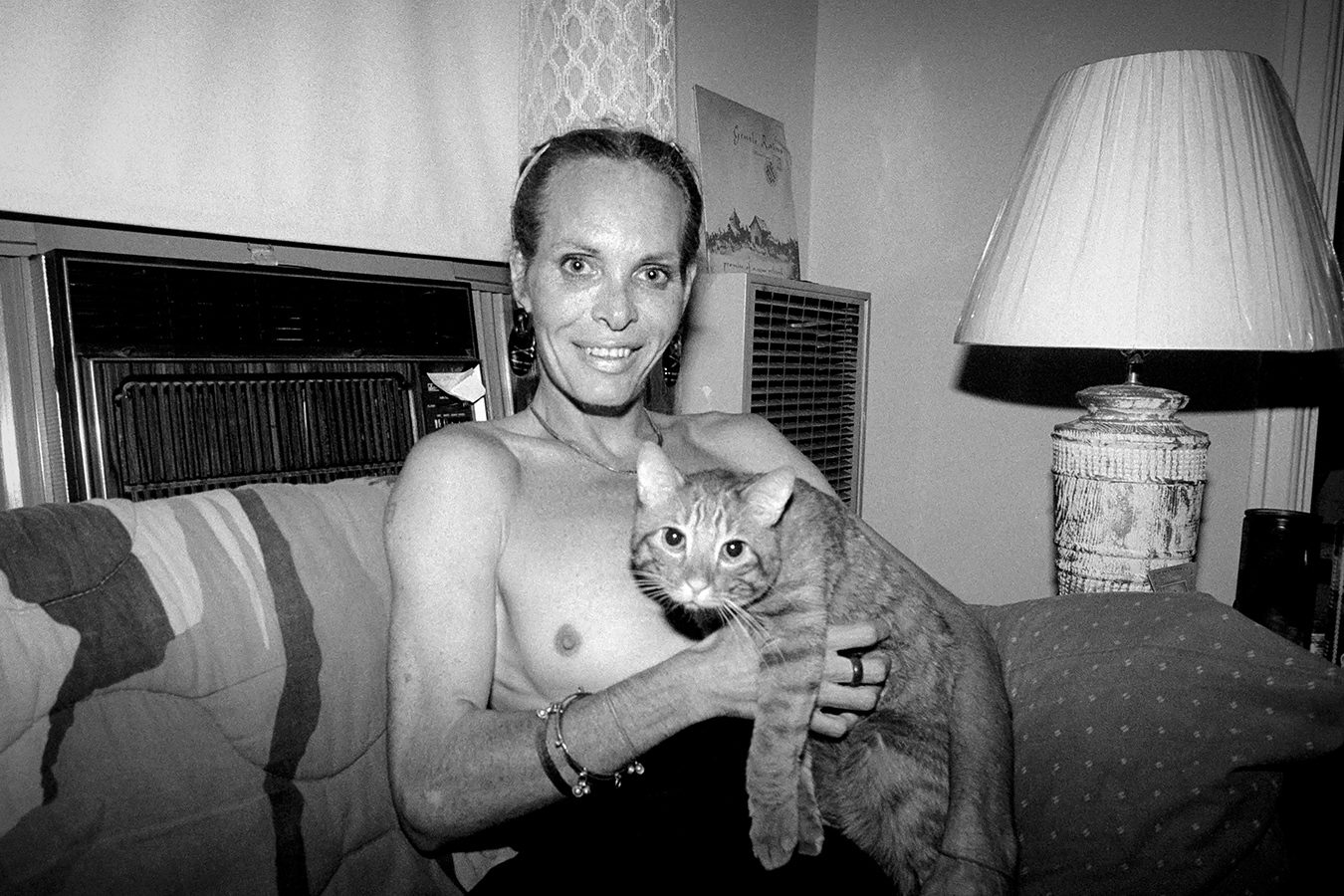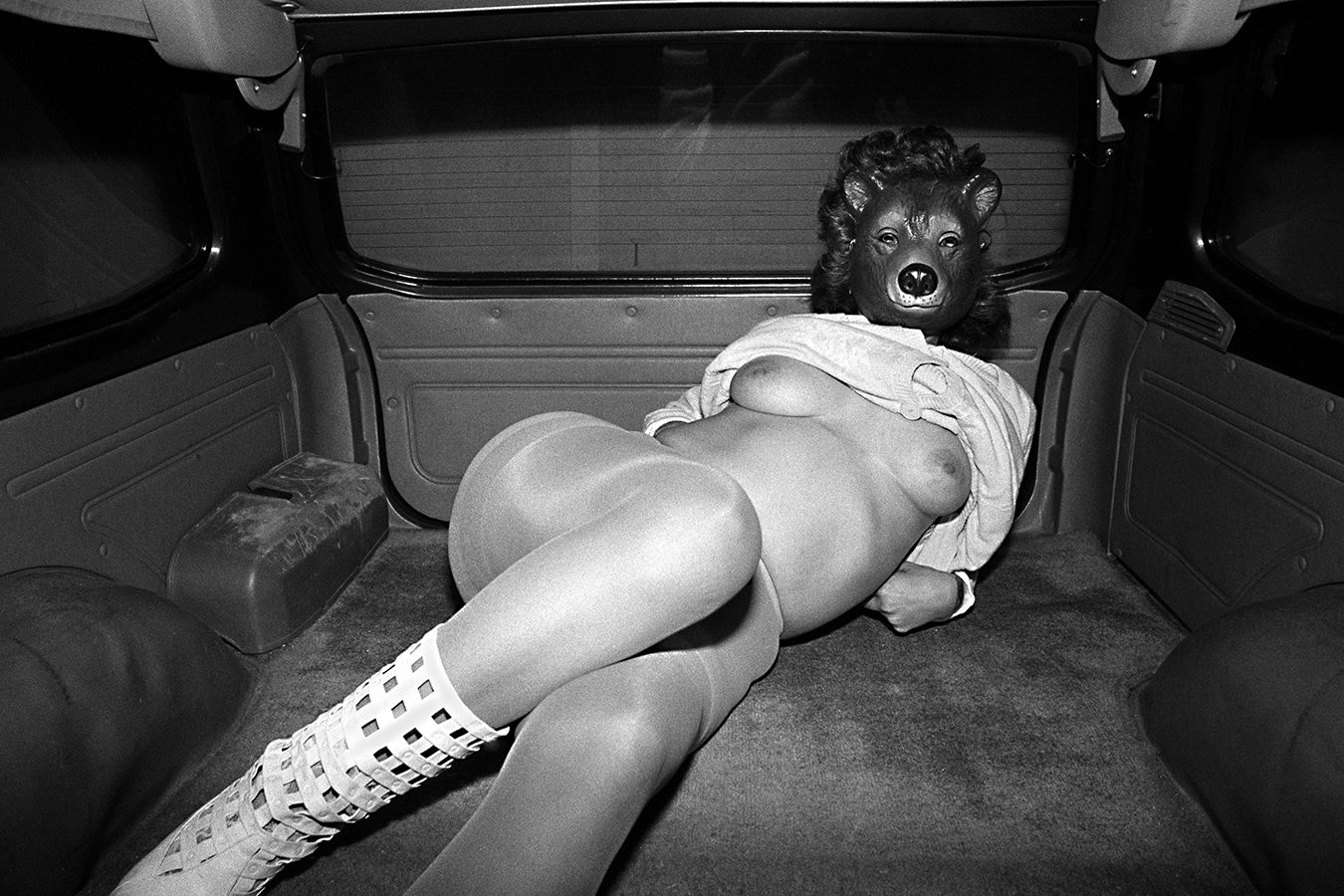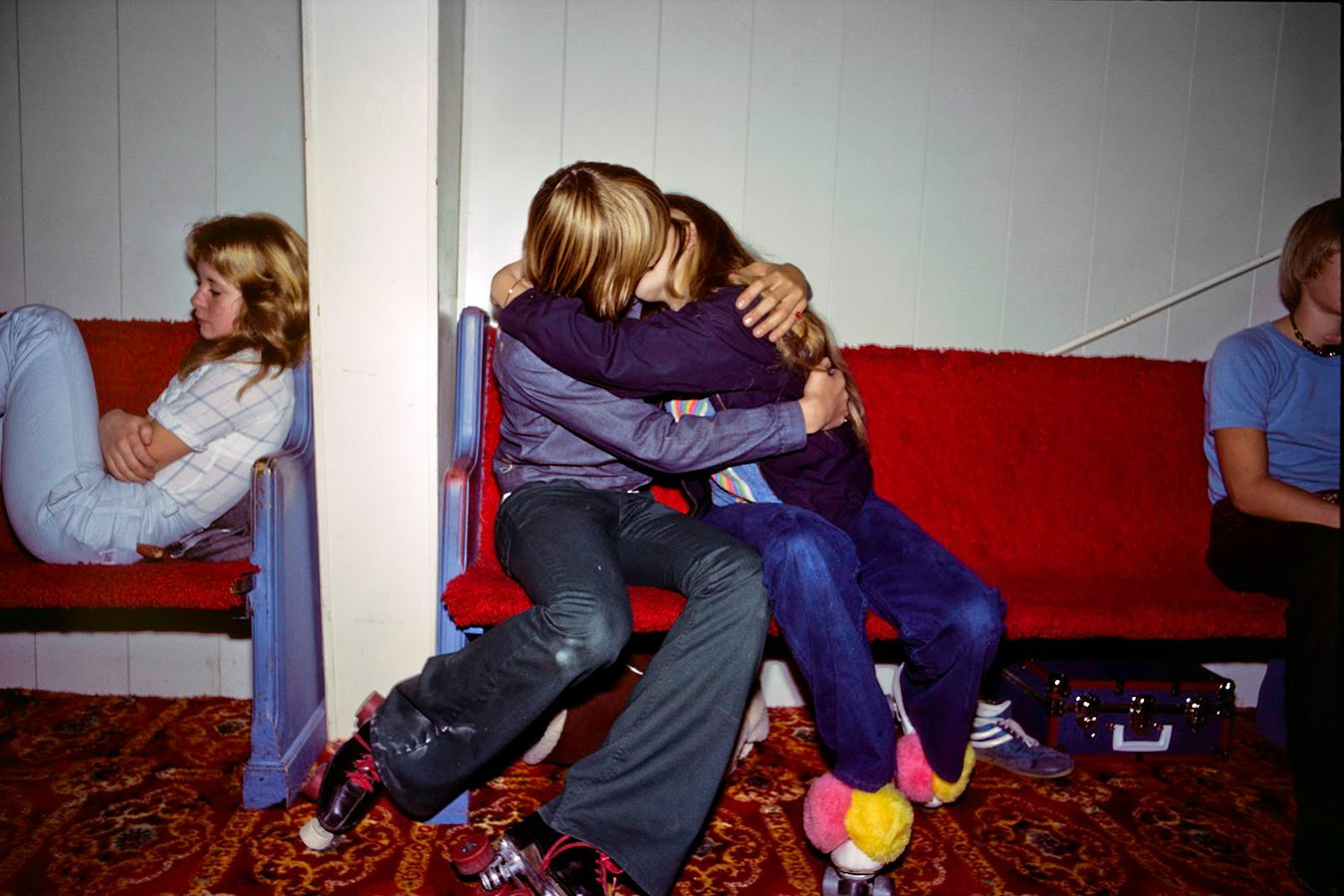 [Editor’s Note: Some photos NSFW.]
[Editor’s Note: Some photos NSFW.]
Just after midnight on a Friday, downtown LA is dotted with clusters of homeless encampments, young men on bikes whistling to one another from corner to alley, and no traffic as far as the eye can see. The ghost town of locked produce markets, steel-gated jewelry shops, closed-down factories and sprawling industrial warehouses sits steps away from the Artwalk district, sushi bars and cupcake bakeries, like a big middle finger in revitalization’s face.
I am cruising the streets with photographer Scot Sothern, author of An American Lowlife (Powerhouse Books) and Curb Service: A Memoir (Soft Skull Press). We are on the lookout for prostitutes, his artistic focus since the ‘60s. A fortuitous show at LA’s DRKRM Gallery put Sothern’s work in the public eye just a few years ago after decades of capturing people of the streets on film. His portraits and stories especially humanize women who trade sex for money, shining a bright light on a diverse and marginalized population many would prefer remain in the shadows. The night is still young for street denizens, he tells me now, slowing on a quiet curve of Lemon Grove Avenue, pointing to a bougainvillea-framed walking tunnel under the 101 Freeway. “I’ve used that spot a lot,” he says. “The ground was covered with flower petals the first time I shot there.”
We drive on, scanning sidewalks and parking lots. A woman rushes by with her head tucked down into a full-length winter coat, uninterested as we slow. Scot is a mild-mannered, silver-haired sixty-something who uses a cane to walk—an unthreatening presence, savvy in the ways of this underworld —but we discuss the fact that me being here could seem suspicious and scare some women away. After a few minutes, he swings the car across two empty oncoming lanes, toward someone he’s sure is working. A tall woman with a ruddy face and frizzy hair emerges from the gray glow.
“Hey, how’s it going?” asks Scot.
“Pretty good,” the woman answers in a sweet, raspy voice, stepping toward the car. I lean forward and look up through the driver’s side window so she can see me, smiling back.
“Wanna make some money?” Scot asks. The woman looks around nervously, and Scot adds: “Can I pay you $20 for three or four pictures?”
“Pictures?” she asks, her face lighting up a bit.
“Yeah, just a few.”
She shrugs and says okay, stepping closer. “Get in the car,” he says, waving his hand toward the backseat, and she does. The interior fills with some sort of drug smell—not body odor but chemicals. I crack the window, and we introduce ourselves. She tells us her name is Sabrina.
“Mr. and Mrs?” she asks, looking back and forth between the both of us.
“No,” I say.
“Yes,” Scot says, “but not with each other.” I wonder if this sounds even kinkier. We commiserate about the “cold” forty-five-degree weather, and Scot asks Sabrina if she has a place we can go. “Yes. Yes I do,” she says. “Behind the Waste Management.”
Scot asks her where she’s from.
“Inglewood…and Honolulu,” Sabrina says. “That’s where all the trouble started.”
Scot laughs, saying he’s not sure when all his trouble started.
“Birth?” I suggest. Our chuckling breaks the ice and Sabrina seems to suddenly remember she’s giving directions.
“OH—it’s right here!” she yells. We hook a left down a dim alley. “I slept back here a few nights when I first came to town,” she says. “This was one of my nooks and crannies.”
“You have a fantastic voice, by the way,” Scot says.
“Thanks. I try to hang on,” she says, like it’s a souvenir from times past.
A thick garbage smell surrounds us. “We’re behind Waste Management?” I ask.
“Yep, they sort the trash here during the day,” Sabrina says. “I worked in Waste Management in Hawaii, and then in Long Beach, so I could probably get a job here if I wanted to…” She trails off while Scot gets his camera ready.
A tall Latina transvestite in booty shorts and a white leather jacket deliberately walks our way. “Want to join the party?” Scot asks.
“What are you doing?” She smiles at me through heavy, maroon lipstick while tightening her jacket around her black bra and otherwise naked torso.
“Taking pictures. He’s a photographer.”
She looks excited for a second, then her jaw sets and she sniffs “I’ve gotta work,” rolling her eyes and stomping off in some super-high espadrilles. I nod and our focus shifts back to Sabrina.
“How about you lay sideways up there, on the platform?” Scot suggests, pointing. Sabrina walks over and hops up backwards, then lies down on her side, head propped on her elbow-supported hand. I hang back by the car, so as not to disturb the process. Scot snaps a photo, and he and his subject banter.
“How about you flash me?” he asks.
Sabrina smiles, almost shyly, lifting her shirt halfway up her torso, revealing a white sports bra. He snaps another photo and she drops the shirt back down.
“Can we do another, bigger flash?” Scot asks. “That was sort of like a half-flash.” Sabrina giggles and says “sure,” while lifting the shirt and bra higher this time, revealing one breast.
“Okay, that’s all there is to it,” Scot says, lowering the camera.
Sabrina jumps down. “That’s it?”
“That’s it.”
Scot pulls a twenty from his wallet and hands it to her. I walk over, thinking we’ll say our goodbyes, but he asks if Sabrina and I want to do one together. “Sure,” I say, and we arrange ourselves between two yellow loading dock posts. I reach an arm toward Sabrina’s shoulder, to bring her in closer, and she takes my hand. We could be friends, posing together after a victorious hike. We could be long-lost sisters, recently found on Facebook. We could have just met at a party. We squeeze our hands together, the camera flashes, and I think, Peace be with you, the only part of Mass I ever liked when I was a church-going kid. We shift a little and Scot takes one more.
“Thanks. That was fun,” Sabrina says, turning toward me with a big grin.
“It was,” I agree.
“Do you need to go anywhere, or do you want me to bring you back to where you were?” Scot asks.
First Sabrina says no, and then: “Yes, 6th and Gladys. I need to go to my father’s house.”
We all hop back in the car, and as Scot proceeds to the coordinates, Sabrina says, again, “That was fun.”
“You didn’t know you’d be a model tonight, huh?” I ask.
“Yeah,” she laughs. “I was just looking for a date.”
“Hopefully that was more fun than a date,” says Scot. Suddenly, he slows in front of a closed-up market on a main street. “Can we do one more here?” he asks, looking in the rearview mirror. He can’t resist the rich red wall as backdrop. Sabrina says sure, and they get out to snap a few as I stay in the car, its driver’s side door hanging wide open.
***
The Rumpus: Curb Service is so detailed with years and places. Did you keep a journal or do you just have a great memory?
Scot Sothern: I went back and researched some things. The first chapter takes place in a Denny’s, and recently I went back, and I went in and there’s not a counter, and I know I was sitting at a counter. Maybe I was down the street at House of Pancakes or they removed the counter? I don’t really trust my memory but then again, it doesn’t really matter. I have a brother and a sister, and when the three of us get together—which is rare—we’ll all remember an event that took place in 1965 and get three completely different stories. I saw Mary Karr talk once, and she said that her dialogue is word-for-word, but I can’t imagine. My dialogue comes from what I think was said and feelings I had. That’d be pretty cool to be able to do that. Certain things people say to you that you’ll remember forever.
Rumpus: Have any of the people you’ve shot been in touch since your work has come out, or have you worried about that?
Sothern: I sometimes wonder how many of them are still around. So many people who do this sort of thing—photographers, especially—talk about, they get to know a person first and get their trust and spend days meeting with them. But I’d pick somebody up on the street, take their picture—maybe more, maybe not—then say “it was nice meeting you, here’s $40,” and never see them again.
There was one woman in Hollywood who I met, who had an apartment close by, and we went there. She was kinda nutty and she showed me all these things she had, like a big mask from the King Tut exhibit that was in town, and she wanted me to take a picture of her reading a bible, and posing with her cat, and all these different things. So I took them and stayed an hour-and-a-half—longer than usual—and we talked a bit. I left and figured I’d never see her again. A year or so later, I picked up a woman and we went to an alleyway to take some pictures. I don’t know what she was on and she was just out of it, and I realized halfway through it was the same woman, but the year before she’d had her hair pulled back tight, and now it was out and wild and kind of appropriate for her manic behavior. She didn’t remember me at all. I’ve always thought that, too. It’s likely that none of them remember me.
Rumpus: You never know. There probably weren’t many guys who took photos and were polite. You don’t paint yourself as a saint, but it’s obvious in your book that you had a lot of empathy for these people.
Sothern: I do care. I picked up strays—other people—as a kid, and I still do that.
Rumpus: Do you see a big difference in the women working the streets today versus the ‘70s and ‘80s?
Sothern: They’re safer now—they have cell phones and mace—but it’s the same. Cell phones do make them a lot safer. A lot of it depends on what part of town you go to. In Hollywood, it seems like a whole different class, and they’re coming from somewhere else specifically to Hollywood, where they can make a little more money, and they’re dressed for work. Whereas you go down to Skid Row and they’re wearing whatever they’ve got, and they’re desperate and will take whatever you give them. They’re working for a fix, not a pimp. I don’t like pimps, and I avoid them as much as possible.
Rumpus: It seems like you were never interested in photographing escorts or going to high-end hotels.
Sothern: I never really had the money and I wasn’t interested, because that’s a whole different thing. I started out without much intention on doing anything other than getting laid and taking some pictures. The more I did, the more involved I became. Then it got to the point where it was really people on the street that interested me, and I felt like escorts and people like that were better left for someone else.
Rumpus: When and why did it turn into more than “getting laid and taking pictures” for you?
Sothern: I came of age thinking whorehouses were kind of romantic, you know, dark and illegal forays with nasty sex, low lights, and cigarette smoke. When I began photographing the prostitutes, I was just going back to where I always ended up, anyway. I guess I figured, As long as I’m here, I should be taking pictures. I didn’t have a political agenda, but my fuck-you politics have always been front and center, hopefully with every picture I make. I was aware I was making photographs that got a reaction, and for twenty years, that reaction was rejection. Nobody wanted to look at it.
I started the series without a lot of forethought, but it’s not like I was doing it just for fun, then hit a dividing line and everything changed. I knew that most sex workers are born victims, abused and exploited and discarded by a world of assholes not much different than me. From the very beginning something about the intimacy of making their portraits, and then later looking at the pictures, made me realize how fucking depressing it was. I’d like to think I’m giving voice to a crush of people who need to be heard from, but at the same time, the pictures I make are largely self-portraits, and the words and stories are distinctly my own. I don’t belong to any advocacy groups, but I know they are out there and I encourage looking them up and helping whenever possible.
Rumpus: What are the legalities of something like this? Were your publishers ever worried?
Sothern: I wasn’t in any position to ever say, “Hey, can you sign this release form?” I do a column, “Nocturnal Submissions,” on VICE, and just recently they went back through my columns and put censor strips on the photos, so I guess there are some concerns and it’s best to play it safe. The fun thing about VICE is I sometimes get hate mail—not so much with the prostitute stories but with the new column, “Sothern Exposure.” I kind of like it. One of them recently said, “Fuck you. Just fuck you.” It was great!
Every so often people say I’m making this great profit off the book and quite honestly, if I talk about money, I still don’t come close to covering what it cost me to do all this in the first place. I insisted on the censor bar on the cover, but as much for aesthetic reasons as anything else. I just liked the way it looked.
Rumpus: Is shooting harder now that people are savvier about curating their online personas?
Sothern: Yeah. That’s everywhere. When I first started shooting all kinds of people in the ‘70s, I could literally grab anybody, anywhere, and say, “Excuse me, I want to take your picture, and we need to walk a block over here, because I want you to stand in this light,” and they’d do it. It was an amazing thing, the control I used to have with a camera. It gave me license. You’d stand in the street with a tripod and the traffic would just go around you. Now they’ll honk and try to run over you!
My favorite all-time picture I ever took is from 1975 in Florida. It’s two kids on roller skates, kissing. There’s two other kids, who are kind of alone, sitting on a bench. They were maybe thirteen or fourteen years old. At the roller rink they would turn off the lights, and they had the music, and all the kids would kiss and neck, so I focused ahead of time for when they turned off the lights, and I took the picture. I spent the evening at the roller rink just taking pictures.
A couple of months ago in Glendale, I noticed a roller rink. I hadn’t seen one in years, so I pulled in and went inside with my camera, and went to the counter and asked if it was okay if I took some pictures. And I thought they were going to call the police. I’m not shooting on the street much anymore—I’m just about finished with it—but a lot more people these days say no, which is fine. I never try to talk them into it, and I do tell them what it’s for.
Rumpus: There’s a real sweetness to your relationship with your dad, in the book.
Sothern: He was a sweet guy. Naïve. I had just a few little tidbits about my dad in the book at first, and my editor at Soft Skull suggested I do more. That was the major suggestion he made, and it made a big difference for me. I had so much of my son and to put my dad in there as well made sense.
Rumpus: Did your dad ever get to see this work?
Sothern: He did. Not all of it, but he saw a good bit of it once, in the ‘80s. He told me that the composition and the lighting were really good, which was great. He didn’t understand it, of course. There’s a thing a lot of people used to say, where they don’t understand why I would photograph someone “so unattractive.” It kind of pisses me off. My brother—who recently read my book and told me he’s sorry, but I’m a degenerate—he kind of questioned that, too. It shows a complete lack of understanding of what it was that I was doing.
Rumpus: I feel like you see the beauty in these people.
Sothern: I do, and I kind of fall in love with them as well. I know I’ve said this in other interviews and maybe in Curb Service, as well: in the ‘60s and ‘70s, my father used to shoot around fifty weddings a year. He told me once: “You look through the camera lens at the bride and you’re looking at her though the eyes of the groom, and on that day, through his eyes, she’s the most beautiful woman alive.” I kind of adopted that attitude for a lot of my pictures, and when I’m photographing a prostitute, I’m trying to look at her through the eyes of the one person that loves her, or him, unconditionally, even if that person never really existed except in these few moments.
I came from a time and place where you could love good girls and you could fuck whores, and they were separated by a line of propriety. I remember in my teens, reading Lenny Bruce’s book How To Talk Dirty And Influence People, and a section where he describes falling in love with his future wife, Honey, while she was stripping onstage in a skeezy bar full of men with stiffies—it was kind of a dawning for me, you know, like maybe it’s the girls who fuck that you love the most. I don’t think Bruce was ahead of his time, so much as I was living in a kind of idiot culture.
Rumpus: I see your work as a commentary on class, too. You’re very aware of your own privilege moving through the world.
Sothern: I give a lot of credit to my mother. At Christmastime, my mother always took packages out and drove around town and made me go with her. I think I always felt like I kind of didn’t deserve the privilege somehow. Upper-middle-class white, American male—other than being born a king, there’s not much that’s easier. I think sometimes people just don’t see what’s around them.
I am political. Some people have said I reminded them of Bukowski, but I think Bukowski’s an asshole. He’s a fantastic writer, but I don’t want to remind people of him.
Rumpus: Your story is also one of artistic struggle, because you were true to your vision for many years without any recognition or accolades. It seems like you were working in a vacuum for so long. What’s it like now?
Sothern: I’m still waiting for the money. I’m getting older and Social Security is not gonna do it. I’ve got a box full of rejection slips from galleries, museums, publishers, and editors. I started submitting stuff in the ‘70s. The DRKRM Gallery show happened three years ago and that lead to all of these other things.
I think when I was younger, a lot of it was my own fault. I think I wasn’t ready, somehow, and I blew my opportunities. I do know now I’ve done so much hustling and promotion and I was really ready for it. I never thought I’d be an inspiration to other people but now I’m getting letters from young photographers. I sent one to my mother the other day. It’s great. I thought everyone was going to hate me. I kind of still wish someone would.
Rumpus: Hey, you’ve got the comments section of VICE.
Sothern: There’s always that to fall back on.
***
First photograph: “Billie” © by Scot Sothern.
Second photograph: “WeeGee” © by Scot Sothern (appears in Curb Service).
Third photograph: “Teen Love on Skates” © by Scot Sothern.
Fourth photograph: “Sheba” © by Scot Sothern (appears in An American Lowlife).








